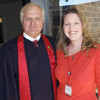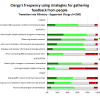Communication and Relationships

The art of pastoral ministry and leadership depends on the arts of communication: proclaiming and preaching the Gospel, teaching and instructing, connecting people to other people, meeting with different groups and individuals, facilitating a community’s care for one another, assuring that the faith community and broader public know about various events. Through these communications and others, pastors and priests seek to nurture strong, healthy, life-giving relationships within the church and connect with those in the wider community.
As new methods of communication have multiplied over the past decades, clergy have had more choices about how to communicate with all the groups of people whose lives they touch. They email, text, post on Facebook or Twitter, upload videos onto YouTube—and they are constantly adapting their strategies about when to use different methods.
This section explores how effectively recently ordained clergy communicate, face-to-face, with large and small groups, and through technology. It also asks questions about where they learned their communication skills and whether they get feedback to assess whether their communications are having the intended effect.





